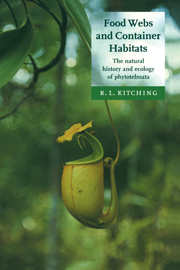Book contents
- Frontmatter
- Contents
- Preface
- 1 Introduction
- Part I The container flora, fauna and environment
- Part II Methods and theories
- Part III Patterns in phytotelm food webs
- Part IV Processes structuring food webs
- 12 Competition and predation – basic forces structuring the community?
- 13 Stochasticism and determinism: processes structuring food webs in phytotelmata
- Part V Synthesis
- Annexe: The phytotelm bestiary
- References
- Index
13 - Stochasticism and determinism: processes structuring food webs in phytotelmata
Chapter 6 revisited
Published online by Cambridge University Press: 26 August 2009
- Frontmatter
- Contents
- Preface
- 1 Introduction
- Part I The container flora, fauna and environment
- Part II Methods and theories
- Part III Patterns in phytotelm food webs
- Part IV Processes structuring food webs
- 12 Competition and predation – basic forces structuring the community?
- 13 Stochasticism and determinism: processes structuring food webs in phytotelmata
- Part V Synthesis
- Annexe: The phytotelm bestiary
- References
- Index
Summary
So what do all these patterns tell us about the underlying dynamics that form food webs within phytotelmata? Chapter 6 is a personal attempt to bring together those ideas which seem to me to be relevant to this ‘big’ question. The four boxes within Chapter 6 summarise these ideas as a series of emergent hypotheses and associated predictions. These can now be put to the question in light of the patterns described in the preceding chapters.
It must immediately be said that some of the hypotheses identified can be tested only anecdotally from available information; others are but weakly tested; a few we can be a little more confident about. By bringing together the theoretical base (from Chapter 6) with available information (all other chapters) I hope to be able to define, at least by implication, the state of the art as far as the ecological understanding of phytotelm communities is concerned. If our understanding is found wanting (as it certainly is on some issues) then such a treatment should identify future areas for further investigation.
I shall use the numbered hypotheses of Boxes 6.1 to 6.4 as the structuring device for this chapter.
The global scale
Four separate processes are of interest when considering the determination of food-web pattern along gradients defined at the global scale: continental drift, host plant biogeography, adaptive radiation, and synoptic environmental conditions.
Information
- Type
- Chapter
- Information
- Food Webs and Container HabitatsThe Natural History and Ecology of Phytotelmata, pp. 275 - 290Publisher: Cambridge University PressPrint publication year: 2000
